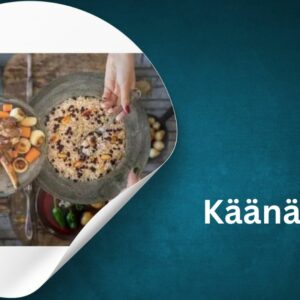Käänät, a cherished Finnish delicacy, has long held a special place in the hearts and kitchens of Finland.
Known for its unique flavors and traditional preparation, käänät embodies the rich cultural heritage of the Finnish people. This comprehensive guide delves into the history, preparation, variations, and cultural significance of käänät, offering insights and analyses that go beyond existing information.
Let’s explore how this delightful dish continues to captivate food enthusiasts around the world.
The History of Käänät
Origins and Cultural Significance
Käänät has been a beloved staple in Finnish cuisine for centuries, with its rich history tracing back to the rural heartlands of Finland.
This traditional dish is not just a meal but a symbol of Finnish heritage and culture. Traditionally prepared during festive occasions and family gatherings, käänät embodies unity and celebration, bringing loved ones together around the dining table.
Its preparation methods and recipes, which have been meticulously passed down through generations, help preserve its authenticity and cultural significance.
This continuity ensures that every bite of käänät is a connection to the past, a celebration of Finnish culinary traditions, and a testament to the enduring legacy of this cherished delicacy.
Read More: GDP – Deleted Scene – E355 – Unveiling the Hidden Layers
Evolution Over Time
While käänät has retained its traditional essence, it has also evolved with modern culinary trends.
Contemporary versions of käänät incorporate new ingredients and techniques, making it a versatile dish that appeals to a broader audience.
Despite these innovations, the core elements of käänät remain intact, honoring its historical roots.
Ingredients and Preparation
Essential Ingredients
The key ingredients for käänät include:
- Rye flour
- Butter
- Milk
- Salt
- Different fillings such as cheese, meat, or vegetables
Traditional Preparation Method
- Dough Preparation: Start by mixing rye flour, butter, milk, and a pinch of salt to form a smooth dough. Let the dough rest for about 30 minutes to enhance its texture.
- Filling: Depending on regional preferences, the filling can vary. Common fillings include a mixture of cheese and herbs, minced meat, or a blend of seasonal vegetables.
- Shaping: Roll out the dough into small circles and place the filling in the center. Fold the dough over the filling, crimping the edges to seal it.
- Baking: Bake the käänät in a preheated oven at 180°C (350°F) for about 20-25 minutes until the crust is golden brown.
Variations of Käänät
Regional Variations
Different regions of Finland have their unique take on käänät:
- Lapland: In Lapland, käänät often includes reindeer meat and wild berries, reflecting the local ingredients and culinary traditions.
- Helsinki: In urban areas like Helsinki, käänät might feature more cosmopolitan fillings such as spinach and feta or smoked salmon.
Modern Twists
Contemporary chefs have introduced innovative variations of käänät to cater to diverse palates:
- Vegetarian Käänät: With fillings like mushroom and truffle, or a mix of roasted bell peppers and goat cheese.
- Sweet Käänät: Dessert versions filled with berries and cream, or apple and cinnamon, offering a sweet twist to the traditional savory dish.
Read: Exploring Fun88ML.com – A Comprehensive Guide
The Cultural Impact of Käänät
Symbol of Finnish Heritage
Käänät is more than just a dish; it is a symbol of Finnish heritage and culinary identity. It is often prepared during national holidays, family reunions, and cultural festivals, bringing people together and fostering a sense of community.
Global Influence
With the rise of global cuisine and food tourism, käänät has gained international recognition. Food enthusiasts and chefs around the world are experimenting with käänät, adapting it to local tastes while respecting its traditional roots.
Health Benefits of Käänät
Nutritional Value
Käänät is not only delicious but also nutritious. Rye flour, a primary ingredient, is rich in dietary fiber, vitamins, and minerals.
The use of fresh, wholesome fillings further enhances its nutritional profile, making it a balanced meal option.
Dietary Adaptations
Käänät can be adapted to meet different dietary needs:
- Gluten-Free Käänät: By using alternative flours such as buckwheat or almond flour.
- Vegan Käänät: Substituting dairy and meat fillings with plant-based alternatives like tofu, legumes, and vegetables.
Tips for Making the Perfect Käänät
Choosing the Right Ingredients
For the best results, use high-quality, fresh ingredients. Opt for organic rye flour and fresh, seasonal fillings to enhance the flavor and texture of your käänät.
Mastering the Dough
Achieving the perfect dough consistency is crucial. Ensure the dough is not too sticky or too dry by adjusting the milk and flour proportions as needed.
Experimenting with Fillings
Don’t be tense to get creative with your fillings. Experiment with different combinations to find your favorite version of käänät.
Read: VC7774 – Your Complete Guide to Samsung VC7774 Vacuum Bags
Where to Enjoy Käänät?
Restaurants and Cafes
Many Finnish restaurants and cafes serve traditional and modern käänät. Some popular places to try include:
- Savotta in Helsinki: Known for its authentic Finnish cuisine, including traditional käänät.
- Juuri: A contemporary restaurant offering innovative twists on classic Finnish dishes, including käänät.
Cooking at Home
For those who love cooking, making käänät at home can be a rewarding experience. Follow the traditional recipe or put your spin on it with unique fillings and flavors.
Conclusion
Käänät is a cherished Finnish delicacy that captures the rich culinary heritage of Finland.
With its unique flavors, versatile preparation, and cultural significance, käänät continues to captivate food enthusiasts around the world.
Whether enjoyed in a traditional setting or with modern twists, käänät offers a delicious and meaningful dining experience.
FAQs
1. How is käänät traditionally prepared?
Käänät is traditionally prepared by mixing rye flour, butter, milk, and salt to form a dough, then filling it with a mixture of cheese, meat, or vegetables, and baking until golden brown.
2. Can käänät be made with gluten-free ingredients?
Yes, käänät can be made gluten-free by using alternative flours such as buckwheat or almond flour.
3. What are some common fillings for käänät?
Common fillings include cheese and herbs, minced meat, and seasonal vegetables. Modern variations might include mushrooms and truffles or roasted bell peppers and goat cheese.
4. Where can I try käänät in Finland?
You can try käänät in many Finnish restaurants and cafes, such as Savotta and Juuri in Helsinki.




